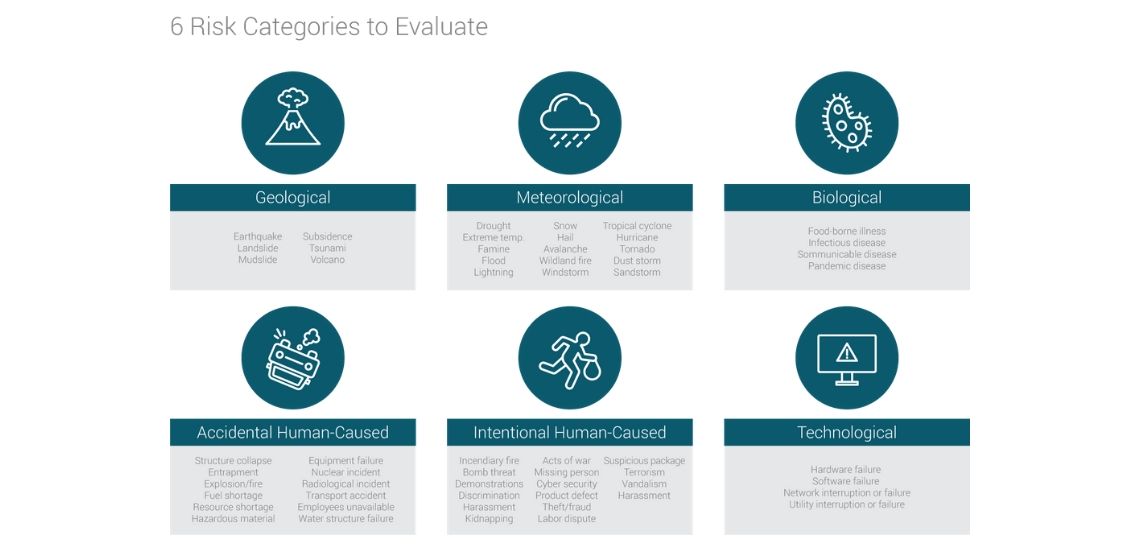6 Types of Business Continuity Risks

Luck favours the prepared
A comprehensive and Standards based BCP will play a crucial role in your organisation's response and resilience to a 'black swan event', ie an unexpected, extremely rare event which is impossible to predict. Examples of black swan events include the 9/11 attacks, The Global Financial Crisis of 2008, the Dot-com bubble of 2000, or BREXIT in 2016. Having a BCP enables a business to identify and reduce potential risks, prepares for risks that are uncontrollable, and creates a plan that will guide the business and employees on how to successfully navigate the situation to recover quickly.
As the famous French scientist Louis Pasteur once stated, “luck favours the prepared”, and being prepared means identifying, addressing, and planning all possible risks that could impact your business.
There are 6 main categories of business continuity risks: Geological, Meteorological, Biological, Accidental Human-Caused, Intentional Human-Caused, and Technological.

Natural Disasters - Geological and Meteorological
Building resilience against natural disasters means implementing a robust BCP and risk management system. Natural events cannot be controlled and as such, businesses need to be prepared for any scenario. Examples of geological risks include earthquakes, landslides, tsunamis and volcanoes. Meteorological risks include a plethora of events, ranging from drought, flooding, tidal surges, geomagnetic storms, lighting, snow, avalanches, hurricanes, tropical cyclones and sandstorms.
Human Caused, both Accidental and Intentional
There are many types of Human-Caused risks, which all come in varying degrees of severity. Many risks come down to human error, such as structural collapses, resource shortages, material spills, transportation incidents, explosions/fires, or the unavailability of essential employees. Sometimes however, Human-Caused risks are intentional, with nefarious purposes. Examples include arson, terrorism threats, harassment/discrimination, acts of war, cyber security attacks, robbery/theft, strikes, vandalism or product contamination. Most Accidental Human-Caused risks can be avoided or mitigated with a comprehensive BCP and thorough use of Standards, whereas Intentional Human-Caused risks are generally more difficult to predict and minimise.
Biological
Biological risks include food-borne illnesses, and infectious/communicable diseases/pandemics. These risks usually require a large scale and all-encompassing response, in order to limit the spread of the illness and/or disease. Foodborne illnesses, such as salmonella or E. Coli, can usually be minimised by correct food processing and handling techniques. Diseases and/or pandemics are harder to predict, with the current COVID-19 pandemic being a topical example of a large-scale Black Swan event that has put almost every single business, across most industries, at risk. The lingering consequences of a disease/pandemic risk can impact businesses at every level, from supply chain and staffing, to consumers and resellers. Such an all-encompassing and unexpected risk like the COVID-19 pandemic is an excellent example for the importance of having a Business Continuity Plan.
Technological
Technological risks are the most recent type of risk to impact business and are increasingly common given society's growing reliance on technology. Examples of technological risks include hardware, software, and network connectivity interruption, disruption, or failure, as well as utility interruption, disruptions or failure.
Prepared and successful
Identifying and understanding the vast variety of risks that could impact a business, helps to formulate a comprehensive Business Continuity Plan to guide through times of uncertainty. Risk management framework is assisted through Standards, and it is highly recommended businesses invest in the ISO 22301:2019 Security and resilience - Business continuity management systems - requirements International Standard, as it suggests the recommended framework for Business Continuity Management . With comprehensive risk management and a Business Continuity Plan comes assurance that your business has a strong chance of navigating challenging situations remaining successful post-risk.

5 Standards key to Business Continuity
Prepare for the unexpected with a business continuity strategy
To assist in with establishing or updating a business continuity management system, there are many Standards an organisation can implement to feel confident when preparing for and responding to a crisis.

8 Benefits of Standards
Compliance with Standards has a range of benefits
Standards can affect an organisation's quality, lead-time, supply chain management and costs. They make trade across international borders easier and promote global competition, having a positive impact on economies.

Standards for Sustainable Cities
Shaping management processes, services and response to risks
Smart cities and communities are using standards to shape their management processes, services and response to risks in order to become sustainable and resilient.
